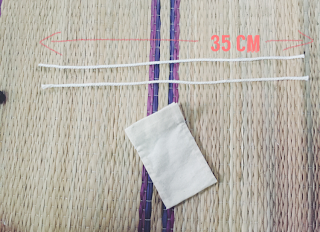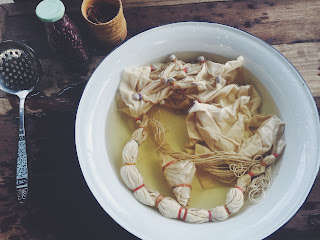สองสามปีก่อน เพื่อนชาวญี่ปุ่นของฉันมาถามหา "soap nut" ว่าหาซื้อได้ที่ไหนในเมืองไทย
เธอบอกว่าอยากเอาไปใช้ซักผ้าแทนผงซักฟอก
ตอนนั้น ฉันยังไม่รู้จักว่า soap nut คืออะไร พอลองเสิร์ชหาดูถึงได้รู้ว่าคือมะคำดีควาย
สมุนไพรไทยของใกล้ตัวที่เอาไปใช้ทำผลิตภัณฑ์บำรุงเส้นผมและเป็นยาแผนโบราณนี้ นอกจากจะใช้ประโยชน์ได้หลากหลาย ยังเป็นที่นิยมใช้กันในหมู่คนรักษ์สิ่งแวดล้อมไม่น้อย
อยู่เมืองไทย หามะคำดีควายได้ไม่ยาก ใช้แล้วไม่ต้องกังวลว่าสารเคมีจากผงซักฟอกจะตกค้าง ไปทำร้ายดินหรือน้ำ ใช้แล้วไม่มีขยะไปกองเพิ่มในบ่อขยะเพราะย่อยสลายได้ทั้งหมด
วิธีใช้มะคำดีควายกับเครื่องซักผ้าก็ง่ายมาก เพียงใส่มะคำดีควาย 4-6 ผลลงในถุงผ้าหูรูด แล้วใส่ลงในเครื่องซักผ้าพร้อมผ้าที่จะซักเลย ซักได้ประมาณ 5 ครั้ง
พอฉันลองใช้ดู โดยใส่มะคำดีควายทั้งผลลงไปแต่ไม่ได้ใส่ถุงผ้าก่อน พอซักออกมาพบว่ามีคราบสีออกน้ำตาล ๆ ติดเสื้อผ้าหลายครั้ง
หลังจากผัดผ่อนมานาน สุดท้ายก็หาเวลาทำถุงผ้าหูรูดจนได้
และนี่คือวิธีทำค่ะ
A few years ago, my Japanese friend asked where could she get soap nuts in Thailand.
She wanted to use it as an alternative for her laundry detergent.
At the time I didn't know its English name, so when I looked up the word, I found that it's an ingredient widely used in hair care products and traditional Thai medicine.
In the past, people used it to wash cloth, dish, jewelry, hair and body before the invasion of commercial detergents took place.
Since it's not hard to find, it's biodegradable, and I don't have to pollute the water or the soil with chemicals, the idea of using soap nut in my laundry sounds great.
I found an easy way to use soap nut in your laundry from WellnessMama, by putting 4-6 nuts in a muslin bag and into your washing machine. It is good for up to 5 loads.
I didn't put mine in a muslin bag and ended up having brownish stains on my clothes.
After dragging my feet for a long time, I finally made time to make a drawstring bag from muslin cloth and here is how.

เจ้าโฮ่ง ๆ ก็มาช่วยด้วย
My dog decided to join me with the sewing.
วิธีทำ -- Instructions
1. ตัดผ้าดิบให้ได้ขนาด 35 x 12 ซม.
7. มัดปมเชือก
7. Make a knot.
8. ทำซ้ำ คราวนี้เริ่มร้อยเชือกจากรูอีกฝั่งหนึ่ง
8. Repeat the process, starting from a different channel you did the first time.
9. วัดจากขอบลงมา 1 ซม. แล้วตีเส้นตามขวาง เย็บตามเส้นที่ตีไว้เพื่อล็อกเชือกไม่ให้เคลื่อน ทำทั้งสองฝั่ง
9. Draw a line crosswise 1 cm from the top edge and sew to keep the cord in place. Repeat on the other side.
เสร็จเรียบร้อย
Complete!
หลังจากเอามะคำดีควายใส่ถุงซักแล้ว ผ้าไม่มีคราบอีกเลยค่ะ
ขอให้มะคำดีควายช่วยซักผ้าให้สะอาดสดชื่น และฟอกใจให้สดใสด้วยค่ะ
The result? No more stain!
Hope these clean and fresh nuts help purifying your clothing and your mind.
เธอบอกว่าอยากเอาไปใช้ซักผ้าแทนผงซักฟอก
ตอนนั้น ฉันยังไม่รู้จักว่า soap nut คืออะไร พอลองเสิร์ชหาดูถึงได้รู้ว่าคือมะคำดีควาย
สมุนไพรไทยของใกล้ตัวที่เอาไปใช้ทำผลิตภัณฑ์บำรุงเส้นผมและเป็นยาแผนโบราณนี้ นอกจากจะใช้ประโยชน์ได้หลากหลาย ยังเป็นที่นิยมใช้กันในหมู่คนรักษ์สิ่งแวดล้อมไม่น้อย
อยู่เมืองไทย หามะคำดีควายได้ไม่ยาก ใช้แล้วไม่ต้องกังวลว่าสารเคมีจากผงซักฟอกจะตกค้าง ไปทำร้ายดินหรือน้ำ ใช้แล้วไม่มีขยะไปกองเพิ่มในบ่อขยะเพราะย่อยสลายได้ทั้งหมด
วิธีใช้มะคำดีควายกับเครื่องซักผ้าก็ง่ายมาก เพียงใส่มะคำดีควาย 4-6 ผลลงในถุงผ้าหูรูด แล้วใส่ลงในเครื่องซักผ้าพร้อมผ้าที่จะซักเลย ซักได้ประมาณ 5 ครั้ง
พอฉันลองใช้ดู โดยใส่มะคำดีควายทั้งผลลงไปแต่ไม่ได้ใส่ถุงผ้าก่อน พอซักออกมาพบว่ามีคราบสีออกน้ำตาล ๆ ติดเสื้อผ้าหลายครั้ง
หลังจากผัดผ่อนมานาน สุดท้ายก็หาเวลาทำถุงผ้าหูรูดจนได้
และนี่คือวิธีทำค่ะ
A few years ago, my Japanese friend asked where could she get soap nuts in Thailand.
She wanted to use it as an alternative for her laundry detergent.
At the time I didn't know its English name, so when I looked up the word, I found that it's an ingredient widely used in hair care products and traditional Thai medicine.
In the past, people used it to wash cloth, dish, jewelry, hair and body before the invasion of commercial detergents took place.
Since it's not hard to find, it's biodegradable, and I don't have to pollute the water or the soil with chemicals, the idea of using soap nut in my laundry sounds great.
I found an easy way to use soap nut in your laundry from WellnessMama, by putting 4-6 nuts in a muslin bag and into your washing machine. It is good for up to 5 loads.
I didn't put mine in a muslin bag and ended up having brownish stains on my clothes.
After dragging my feet for a long time, I finally made time to make a drawstring bag from muslin cloth and here is how.

เจ้าโฮ่ง ๆ ก็มาช่วยด้วย
My dog decided to join me with the sewing.
วิธีทำ -- Instructions
1. ตัดผ้าดิบให้ได้ขนาด 35 x 12 ซม.
1. Cut a piece of 35 x 12 cm fabric.
2. เย็บเก็บริมผ้าด้านยาวทั้งสองฝั่ง
2. Hem both long sides of the fabric.
4. พับผ้าด้านยาวลงมาครึ่งหนึ่ง เย็บผ้าให้ติดกัน โดยหันผ้าด้านถูกเข้าหากันแล้วเย็บไปตามริมผ้าฝั่งยาว เว้นช่องสำหรับร้อยเชือกไว้ เมื่อเย็บริมทั้งสองฝั่งแล้ว กลับผ้าด้านในออก
4. Fold the long side of fabric in half and sew along the hems with right sides facing each other, leaving the drawstring channels. After sewing both sides, turn it inside out.
5. ตัดเชือกยาวเส้นละ 35 ซม. สองเส้น
5. Cut two pieces of 35 cm cord.
2. เย็บเก็บริมผ้าด้านยาวทั้งสองฝั่ง
2. Hem both long sides of the fabric.
3. พับขอบผ้าฝั่งที่กว้าง 12 ซม. ลงมาอีก 2.5 ซม. แล้วเย็บเก็บริมผ้า ทำทั้งสองฝั่ง
3. Fold the 12-cm edges down 2.5 cm on both sides and sew the hems.
4. พับผ้าด้านยาวลงมาครึ่งหนึ่ง เย็บผ้าให้ติดกัน โดยหันผ้าด้านถูกเข้าหากันแล้วเย็บไปตามริมผ้าฝั่งยาว เว้นช่องสำหรับร้อยเชือกไว้ เมื่อเย็บริมทั้งสองฝั่งแล้ว กลับผ้าด้านในออก
4. Fold the long side of fabric in half and sew along the hems with right sides facing each other, leaving the drawstring channels. After sewing both sides, turn it inside out.
5. ตัดเชือกยาวเส้นละ 35 ซม. สองเส้น
5. Cut two pieces of 35 cm cord.
6. ร้อยเชือกเข้าทางรูที่เว้นไว้ แล้วร้อยออกรูอีกฝั่งหนึ่ง ใช้ปลอกปากการ้อยก็ได้
6. Insert the cord through one drawstring channel and out the other channel. I did mine with a pen cap.
7. มัดปมเชือก
7. Make a knot.
8. ทำซ้ำ คราวนี้เริ่มร้อยเชือกจากรูอีกฝั่งหนึ่ง
8. Repeat the process, starting from a different channel you did the first time.
9. Draw a line crosswise 1 cm from the top edge and sew to keep the cord in place. Repeat on the other side.
Complete!
หลังจากเอามะคำดีควายใส่ถุงซักแล้ว ผ้าไม่มีคราบอีกเลยค่ะ
ขอให้มะคำดีควายช่วยซักผ้าให้สะอาดสดชื่น และฟอกใจให้สดใสด้วยค่ะ
The result? No more stain!
Hope these clean and fresh nuts help purifying your clothing and your mind.


























































